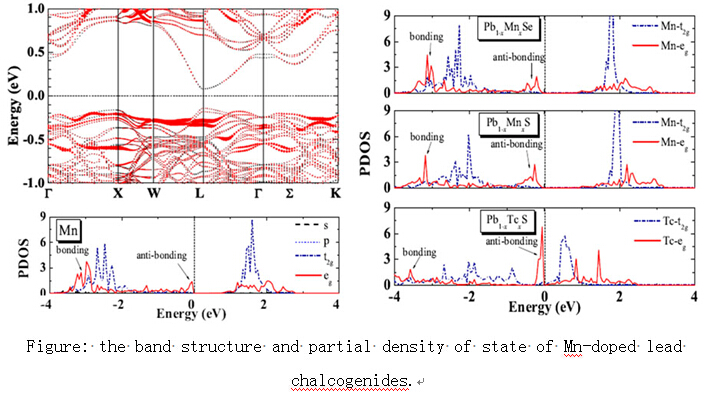Band engineering of PbTe thermoelectric materials has attracted great experimental interest (Science 2008, 321, 554 and Nature 2011, 473, 66).It is also extensively studied by theoretical works aimed at understanding the physics of electronic band modification. Recently, there are some interesting finds concerned the 3d-metal-doped PbTe in experiments. Mn-doping in PbTe causes “multiple valence bands”, while the other 3d metals, such as Ti and Cr, exhibit “resonant state effects” in PbTe (NPG Asia Mater. 2012, 4, e28). The reason why Mn-doping is very different to the other 3d metal-doping in PbTe is unclear.
Recently, Prof. Jiang’s group, Tan and Liu et al. at Ningbo Institute of Materials Technology and Engineering, Chinese Academy of Sciences investigated the electronic structures of 3d metal-doped PbTe by using first-principles calculation with spin-orbital interaction. It is found that the Mn-doping in PbTe enlarges the band gap and increases the valence band’s degeneracy, showing good agreement with experimental measurements. This band adjustment is demonstrated from the anti-bonding of Te-p and Mn-d orbitals.Along the series of PbTe-PbSe-PbS, the band modification of Mn-doping undergoes a gradual transition from “multiple valence bands” type to “resonant states” type, owing to the downwards shifted anion-p orbitals. The main conclusions are:1) the unusual behavior of Pb1-xMnxTe is due to the half occupied d-orbitals of Mn ion, 2) the valence bands of Pb1-xMnxTe are modified by the anti-bonding of Te-p and Mn-d orbitals. The results were published recently in J. Phys.: Condens. Matter.

Prof. Jun Jiang:jjun@nimte.ac.cn
Research Group Url:http://manufacture.nimte.cas.cn/team/guangdian/about/
All Images by![]()

